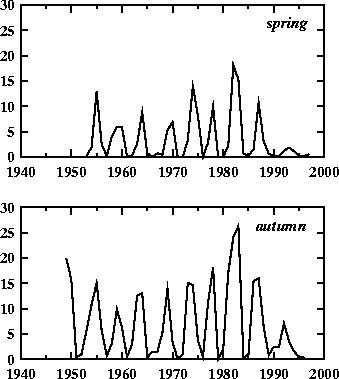Curious features of population cycles
![]() ive features of
population cycles are especially noteworthy:
ive features of
population cycles are especially noteworthy:
- The regularity of the cycles is their most conspicuous feature. From direct inspection of the time series, one sees that although there is considerable variation in the size of maxima, the duration from one maximum to the next is fairly constant. In the case of the ``10-year'' cycle of the snowshoe hare and Canadian lynx, peak-to-peak times range only from 8 to 11 years. In the case of lemming and microtine cycles, 3 to 5 year cycles are the rule.
- The particular periods of the various cycles are themselves remarkable. No climactic cycle of appropriate period has ever been identified. The sunspot cycle of ~11 yrs. is similar in length the the snowshoe hare cycle, but does not stay in phase with it. Some have proposed exotic explanations involving the alignment of the outer planets of our solar system, but this is obviously pretty implausible. If, in fact, the cycles are generated biotically, which aspects of the biology determine the periodicity of the observed cycles?
- The large amplitude of the cycles should be noted. The fur returns show variations over several orders of magnitude. Whereas these harvest statistics almost surely exaggerate the magnitude of the fluctuations, more reliable estimates from direct mark/recapture studies show that real snowshoe hare populations can change two orders of magnitude during the course of a decade. Likewise, as the trapping data shown above make clear, abundances of voles can vary markedly as well.
- The northern distribution of the cycles deserves attention. Cycles among mammal populations are only found at relatively high latitudes. Both among hares and voles, for example, populations at the southern end of the habitat do not show multi-annual cycles.
- Finally, the cycles, at least among hares, are broadly synchronous across much of the North American continent.
M & B Home | Previous | Top | Next

